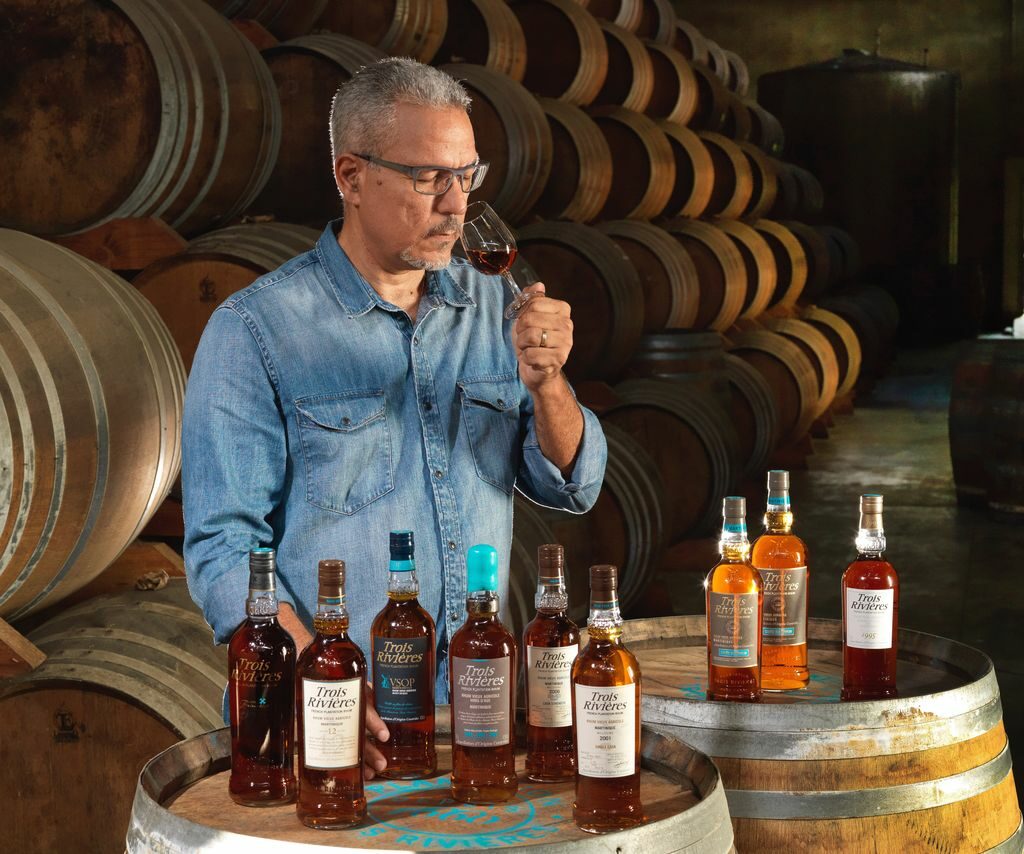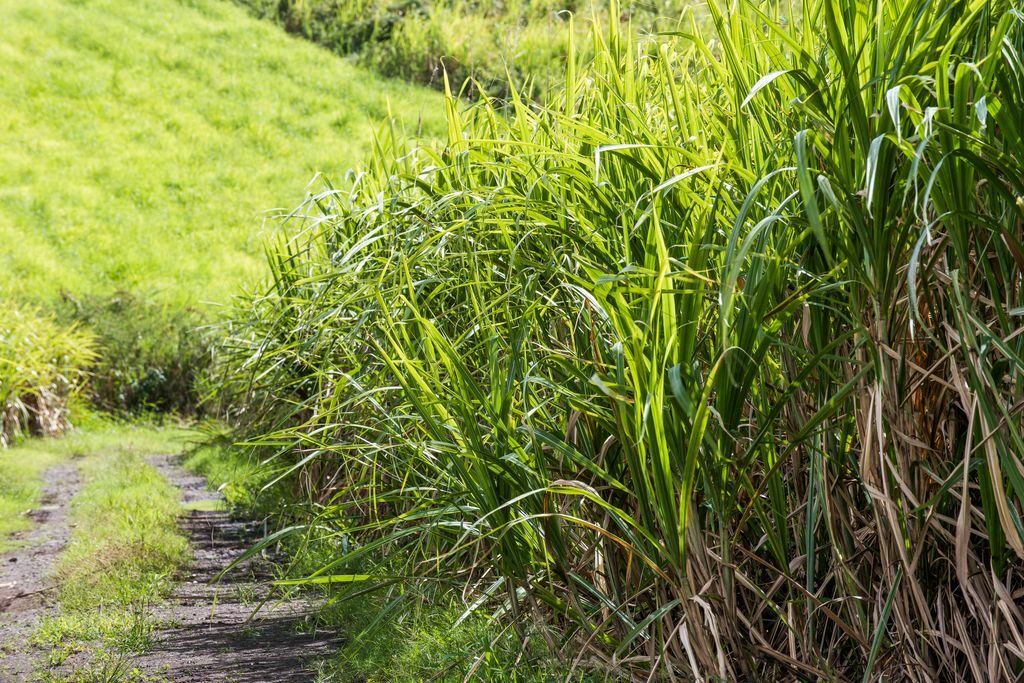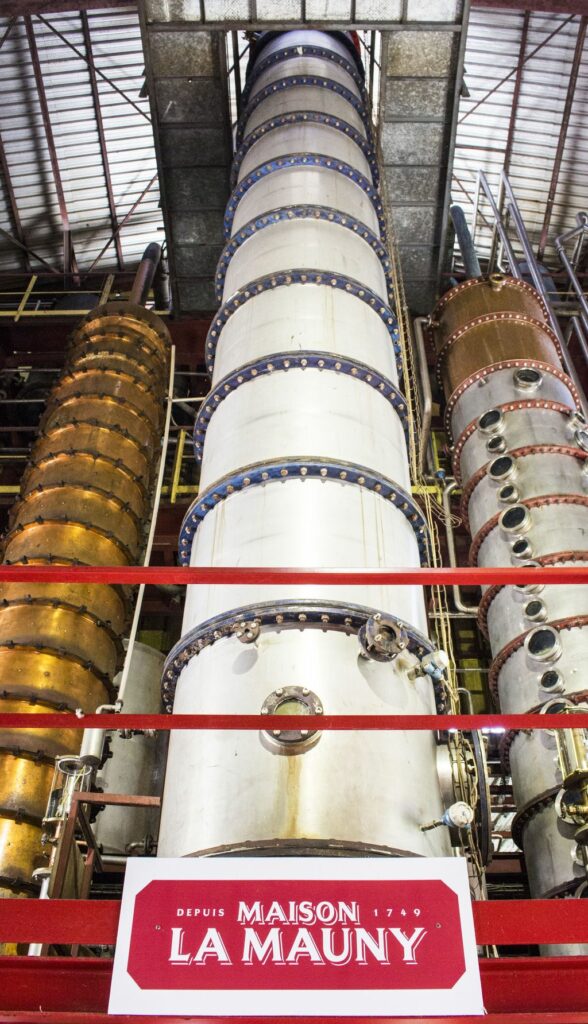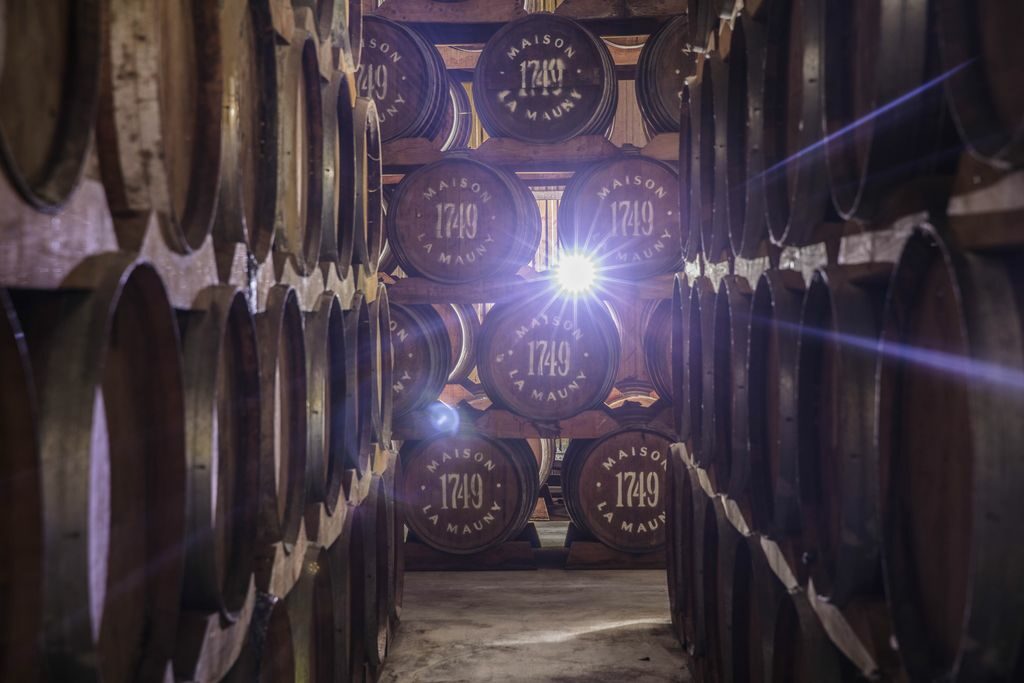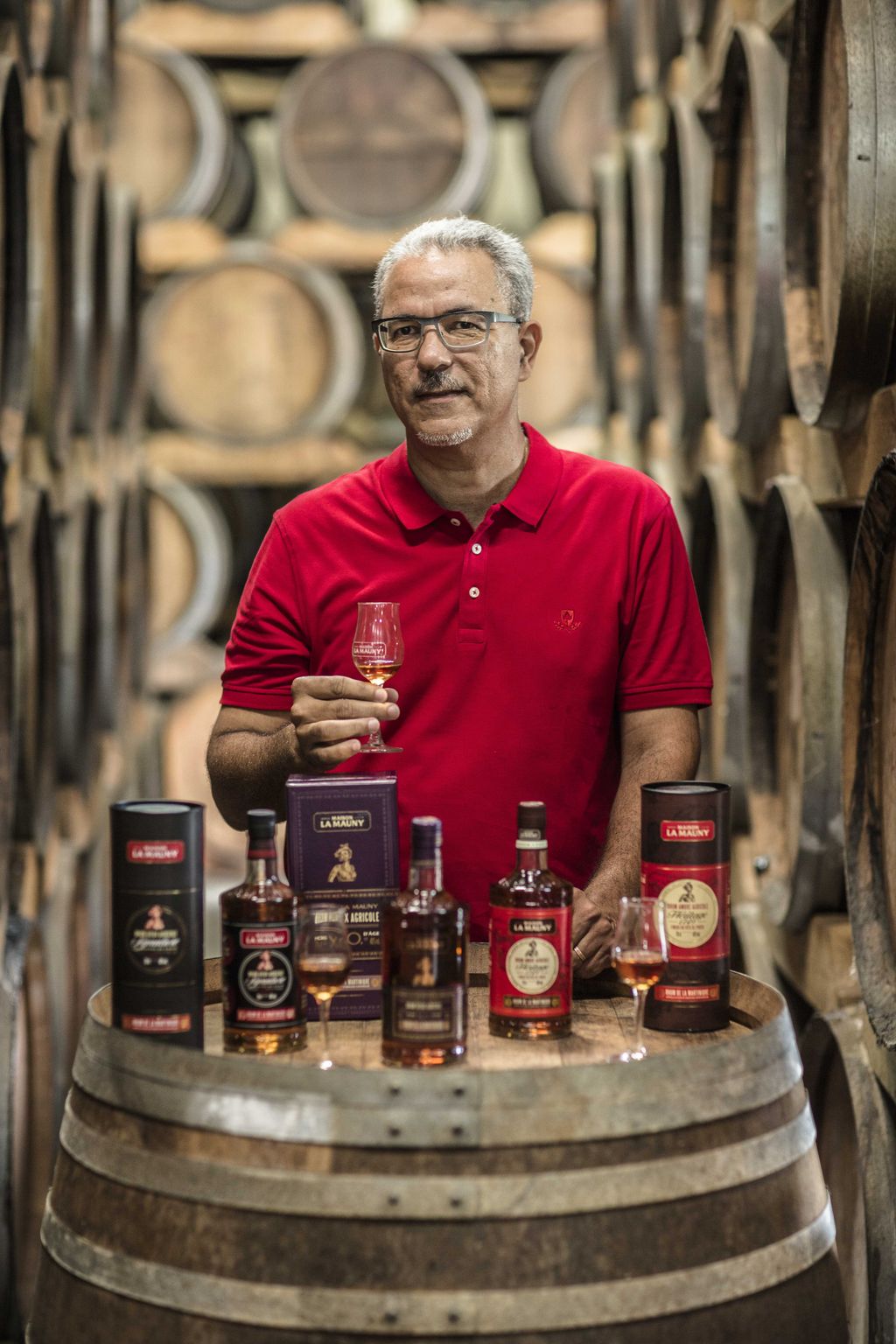
Daniel Baudin est un passionné, un connaisseur, un expert. Élu meilleur Maître de chai au monde en 2018, il travaille depuis 1991 pour Trois Rivières et Maison La Mauny. Ainsi, il réalise depuis plus de 30 ans, avec son équipe, les assemblages et vieillissements des Grandes Cuvées et Millésimes des marques Trois Rivières et Maison La Mauny. Daniel a d’abord été formé par une première maison de rhum en tant que responsable des stocks et des assemblages puis par le Centre Technique de la Canne et du Sucre de la Martinique. Il a ensuite intégré Trois Rivières en 1991 au poste de Maître de chai nouvellement créé pour le suivi des distillations, l’assemblage des lots, le suivi des mises en vieillissements et celui des douanes et de l’AOC.
Au quotidien, il est entouré d’un patrimoine vieux de 300 ans. Les chais des Plantations Trois Rivières et de Maison La Mauny abritent de nombreux millésimes dont les plus vieux encore en vieillissement ont près de 20 ans.
Un travail et une passion reconnus lors des concours internationaux, puisqu’en 2018 le rhum vieux Trois Rivières VSOP a reçu le Rum Trophy of the Year lors de l’« International Wine & Spirit Compétition » à Londres.
Pouvez-vous nous préciser en quoi consiste votre métier ?
Le métier de maître de chai est avant tout un métier pour les passionnés. Il consiste a faire un suivi de la distillation, s’assurer de la bonne maîtrise et de la bonne pratique de la réception de la canne, jusqu’à la distillation, puisque c’est le maître de chai qui prendra le relais dans les chais.
Le maître de chai s’assure de la qualité des rhums entrant dans les chais, par un test organoleptique et physico-chimique (chromatographie). Il organise le stockage et fait un suivi de l’élaboration des rhums (réductions), tient un état des stocks (inventaire régulier), suit la mise en bouteille (vérification du contenu, dégustation, volume par le poids, degrés). Il contrôle également l’état des fûts achetés et de tout ce qui entre dans les chais, suit les mises en vieillissements et l’évolution de ces rhums mis sous-bois, créé la gamme pour chaque marque.
Il fait également les déclarations aux douanes (le SACI) et au syndicat de l’AOC, les demandes de prélèvements en vue du passage devant la commission de dégustation, il organise les contrôles de CERTIPAQ et de la DGCCRF (Direction générale de la concurrence, de la consommation et de la répression des fraudes).
Son rôle est de recevoir les clients, les éduquer à la dégustation, montrer notre savoir faire et représenter les marques sur les salons.
Cela consiste aussi à répondre à des questionnaires, des interviews (journaux et TV), faire des masterclasses, assister des chefs cuisiniers pour des food-pairings…
Et surtout faire en sorte que tout cela soit cohérent.
Êtes-vous entouré d’une équipe ? Comment se compose-t ‘elle ?
Mon équipe est composée d’ 1 assistant maître de chai, de 2 préparateurs / laborantins et d’ 1 tonnelier et de son assistant.
Comment se passe une journée type pour vous ?
Arriver sur le site, aller saluer les équipes, puis donner les instructions de la journée. Lire les mails et y répondre, saisir les données des mouvements de la cuverie, s’entretenir avec la logistique pour organiser les mises en bouteille du jour, s’assurer du bon fonctionnement de la chaîne et faire des contrôles sur celle-ci (cadence, visuel, respect de l’étiquetage, vérifier le volume et le degré des bouteilles plusieurs fois dans la journée, faire des dégustations des fabrications embouteillées), saisir les données de fabrication en fin de journée, une ou deux réunions, déguster les vieillissements.
Et pendant la campagne, monter à la distillerie pour faire des contrôles, réceptionner les distillats, les déguster, les orienter selon les profils organoleptiques, et saisir les données des rhums réceptionnés. Et échanger constamment avec les équipes.
Quelles quantités de rhum sortent des colonnes chaque année ?
Environ 3 000 000 de litres à 55 %.
Avec quelles variétés de canne travaillez-vous ?
Dans l’ordre, on utilise :
CANNE ROSEAU B_59_92.
CANNE PAILLE R_570.
CANNE ZIKAK B_80_08.
CANNE BLEUE B_69_566
Les autres
CANNE ROSEAU B_59_92.
CANNE BLEUE B_69_566.
CANNE PAILLE R_570 ou autres cannes réunionnaises R_582, R_583, R585.
Quels sont les différents sols / terroirs que vous avez à votre disposition ?
À l’extrême sud, nous avons des vertisols sablonneux riches en silice et en argile. Ils correspondent à 28 % du type de sol en Martinique. La porosité naturelle de ces types de sols permet à la matière organique de s’infiltrer, ce qui conduit à une forte activité microbienne et donc une bonne fertilité et une bonne aération du sol.
Les sols les plus rares de l’île (seulement 9 % du territoire) se retrouvent au niveau de la presqu’île de La Caravelle, et une grosse partie à Rivière Pilote, précisément au domaine La Mauny.
Comment définiriez-vous l’identité de chaque marque ?
Trois rivières porte des notes « masculines » (avec du caractère, de la puissance, des notes salées voire iodées)
Maison La Mauny est sur des notes plus « féminines » (avec de la complexité, fruitée, floral, voire miellée)
Pouvez-vous nous présenter les différents appareils de distillation dont vous disposez ?
Nous avons 5 colonnes à distiller, dont une entièrement en cuivre « dite colonne créole ». Elles ont des diamètres différents, ce qui donne à chaque marque une typicité unique. Chaque colonne a son plan de fabrication qui reste inchangé.
Est-ce toujours le même rhum qui sort de chaque colonne, ou bien est-ce que vous faites différents réglages, afin d’assembler des rhums plus ou moins lourds / légers par la suite ?
Pour certaines cuvées la fermentation sera différente, le type de levures aussi.
Chaque colonne donne un rhum unique à quelques variantes près en fonction du flux du débit de son diamètre, du nombre de plateaux épuisements et concentrations….
Les colonnes sont de tailles différentes et offrent des profils organoleptiques différents qui sont ensuite assemblés selon les marques.
Quel est le temps moyen de repos pour un rhum blanc ?
Comme l’exige l’AOC : 6 semaines de maturation.
Le rhum blanc repose en cuve inox.
Pouvez-vous nous parler de la réduction par infusion d’eau ?
Lorsque l’on ajoute de l’eau dans de l’alcool, il y a une réaction exothermique qui se produit. Afin de préserver la totalité des arômes d’un agricole (arômes les plus volatiles), l’eau sera ajoutée au compte goutte (une centaine de litres) sans aucun brassage mécanique.
Un abaissement de quelques degrés à l’entrée en fût est nécessaire, et certains sont réduits durant le vieillissement. On pratique également un ouillage systématique.
Avec quels types de fûts travaillez-vous ?
Nous travaillons avec des fûts de chêne français et américains, neufs et roux.
Pouvez-vous nous expliquer comment se comporte un fût selon sa place dans le chai ?
Chais secs : les rhums sont plus secs, plus alcoolisés…
Dans un chai sec, avec une humidité relative entre 40 et 60 %, l’évaporation porte essentiellement sur le volume avec perte d’eau.
Le titre alcoométrique volumique (TAV) ne varie pratiquement pas.
Les rhums sont plus secs et ont plus de caractère.
Chais humides : les rhums sont plus moelleux, plus ronds…
Dans un chai humide avec hygrométrie relative entre 90 et 100 %, l’évaporation se porte essentiellement sur l’alcool.
Le TAV (Taux d’Alcool par Volume. ndlr) peut baisser sensiblement.
Les eaux-de-vie vieillies en chai humide sont dites moelleuses et rondes.
Comment garder une trace du profil de chaque fût ?
Pour garder la trace, je mets des petits signes sur les fûts afin d’avoir l’info quand je suis dans le chai, mais j’ai aussi des notes que je prends. Aussi, pour tout assemblage, une dégustation de chaque lot est faite, ainsi qu’une dégustation de la cuvée et une dégustation de la gamme pour vérifier le positionnement et l’intégration de cette cuvée.
Qu’est-ce qui fait selon vous la spécificité du rhum de Martinique ?
Les Rhums de Martinique sont de pur jus de canne, et nous avons depuis 1975 mis en place un suivi par le Centre-Technique-de-la-Canne-et-du Sucre, avec un vrai support technique et un conseil qui a conduit à l’AOC.
Comment résumeriez-vous la typicité des rhums AOC Martinique d’un point de vue organoleptique ?
Ce qui reflète la typicité des rhums AOC, ce sont d’abord des arômes typiques :
(Les pourcentages correspondent aux arômes relevés par les dégustateurs du jury AOC Martinique, ndlr)
Pour les rhums blancs
Floral (45%) canne à sucre, fleur d’oranger, miel
Fruité (38%) agrumes, fruits exotiques, (banane, ananas….)
Végétal (12%) thé, tisane, feuilles séchées (tabac…)
Épicés & Aromates (4%) poivre, anis…
Balsamique (1%) “ti baum” , eucalyptus, …
Pour les rhums élevés sous-bois
Fruité (45%) cuit/confiture (agrumes, banane flambée…) confits (figue, datte…)
Floral/Végétal (38%) miel, pain d’épice… thé, tisane
Épicés & Aromates (4%) vanille, cannelle,…
Balsamique (1%) “ti baum” , eucalyptus, réglisse …
Empyreumatique (27%) cacao, bois grillé
Pour les rhums vieux
Empyreumatique (45%) torréfié (café, moka, cacao, chocolat….)
Épices & Aromates (29%) vanille, cannelle, muscade…
Fruité (25%) cuits confiture, pâte de fruits, séchés-confits figue, datte, pruneaux à l’alcool
Balsamique (1%) “ti baum”, eucalyptus…
Mais surtout l’absence de défaut tel que souffre, hydrocarbure, bois pourri, caramel prononcé…
Voici donc les défauts et notes indésirables que l’on ne souhaite pas avoir dans un rhum AOC Martinique (ndlr) :
Pour les blancs
Chimique (53%) solvant, évent, métallique, piquant….
Empyreumatique (27%) caractères de R.I.C. : sucre brûlé, mélasse, sirop batterie…
Fermentaire (15%), rance, butyrique, lacté…
Soufre (5%), ail, oignon, croupi…
Pour les Rhums ESB
Manque de caractère Floral
Chimique (53%), acescence acétique, caractère aux notes acide, oxydé….
Fermentaire / soufre (5%), rance, butyrique, lacté, ail, oignon…
Pour les vieux
Floral (53% ) caractère du rhum blanc
Végétal (22%) sciure de bois, bois humide, végétal sec…
Chimique (20%), acescence, oxydé (pomme, sapotille, fruits blets)…
Fermentaire / soufre (5%) rance, butyrique, lacté, ail, oignon…
Les défauts d’ajournement lié au process pour tous les rhums
Chaudière, métallique, chimique, soufre, éthéré, ABG (alcool bon gout) ou pharmacie, oxydé, piquant, acescence, fermentaire, rance.
Les défauts d’ajournement lié au type de rhum
Blanc : boisé
Rhum ESB : caramel
Rhum Vieux : caractère de blanc : floral, végétal (sciure, bois humide, ) manque de vieillissement, caramel.
Et pour tous les rhums
Sucre brûlé, RIC, mélasse, sirop batterie ou autre eau de vie
Qu’est-ce qui fait que les rhums AOC Martinique sont si immédiatement reconnaissables ?
La réponse est contenue dans la réponse précédente : « pas de défauts ».
Cela devient de plus en plus compliqué. Il y a 10 ans il était beaucoup plus facile de faire la différence immédiatement.
Avez-vous une cuvée préférée ? Le souvenir d’un millésime particulier ?
Maison LA MAUNY Nouveau Monde, la cuvée princesse, le Millésime 1982. De par la complexité de la formulation et la richesse en dégustation.
Quels rhums conseilleriez-vous à quelqu’un qui voudrait découvrir Trois Rivières ou La Mauny ?
Le Trois Rivières VSOP et le La Mauny XO sont les deux rhums qui marquent bien le style de chacune des marques. Le Trois Rivières VSOP a du caractère et de la puissance. La Mauny XO est tout en dentelle.
Aujourd’hui les producteurs martiniquais n’hésitent plus à sortir de l’AOC, diriez-vous qu’un certain vent de liberté souffle sur l’île ?
L’idée n’est pas de sortir de l’AOC. C’est juste de montrer notre savoir-faire en dehors de l’AOC et surtout pouvoir accompagner ou faire entrer les non-connaisseurs dans l’univers du rhum agricole.
La demande constante de nouveauté fait que la cadence des nouvelles sorties s’intensifie, comment conserver l’ADN de chaque maison dans ces conditions ?
Pour garder l’ADN de chacune des marques, il faut re-tester toute la gamme et faire un assemblage avec l’ancienne cuvée.
Comment voyez-vous l’avenir du rhum dans les années à venir ?
Dans le monde des alcools, les rhums ont un bel avenir (Rhum Ron Rum), ils sont très complexes quand ils sont bien travaillés.
Est-ce que vous buvez et appréciez d’autres rhums que ceux des Antilles françaises ?
Lors des salons tenus hors de l’île, j’ai pu déguster des rhums de sucrerie de New Grove, qui se distinguent par leur caractère fruité, floral, légèrement boisé.
